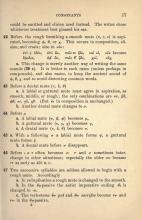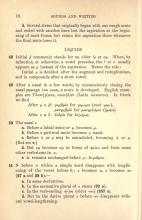42. Before the rough breathing a smooth mute (π, τ, κ) is aspirated, becoming φ, θ, or χ. This occurs in composition, elision, and crasis; also in oὐκ.
ἐπὶ + ὁδός ⇢ ἔφοδος
ἀπὸ ὧν ⇢ ἀφʼ ὧν
παῖς τε ἥδε ⇢ παῖς θʼ ἥδε
καὶ + οἱ ⇢ χοἰ
οὐκ ⇢ οὐχ
a. This change is merely another way of writing the same sounds (§ 38.c). It is better in such cases (unless perhaps in compounds), and also easier, to keep the ancient sound of φ, θ, χ and so avoid distorting common words.
43. Before a dental mute (τ, δ, θ)
a. A labial or guttural mute must agree in aspiration, as smooth, middle, or rough; the only combinations are πτ, βδ, φθ, κτ, γδ, χθ. (But ἐκ in composition is unchanged.)
b. Another dental mute changes to σ.
44. Before μ
a. A labial mute (π, β, φ) becomes μ;
b. A guttural mute (κ, γ, χ) becomes γ;
c. A dental mute (τ, δ, θ) becomes σ.
45. a. With a following σ a labial mute forms ψ, a guttural mute forms ξ.
b. A dental mute before σ disappears.
46. Before ι a τ often becomes σ. τ and σ sometimes interchange in other situations; especially the older σσ became ττ as early as 450 Β. C.
47. Two successive syllables are seldom allowed to begin with a rough mute.
a. In reduplication a rough mute is changed to the smooth.
b. In the θη- passive the aorist imperative ending -θι is changed to
-τι.
c. The verb stems θε- (put) and θυ- (sacrifice) become τε- and τυ- in the θη- passive.
d. Several stems that originally began with one rough mute and ended with another have lost the aspiration at the beginning of most forms, but retain the aspiration there whenever the final mute loses it.


